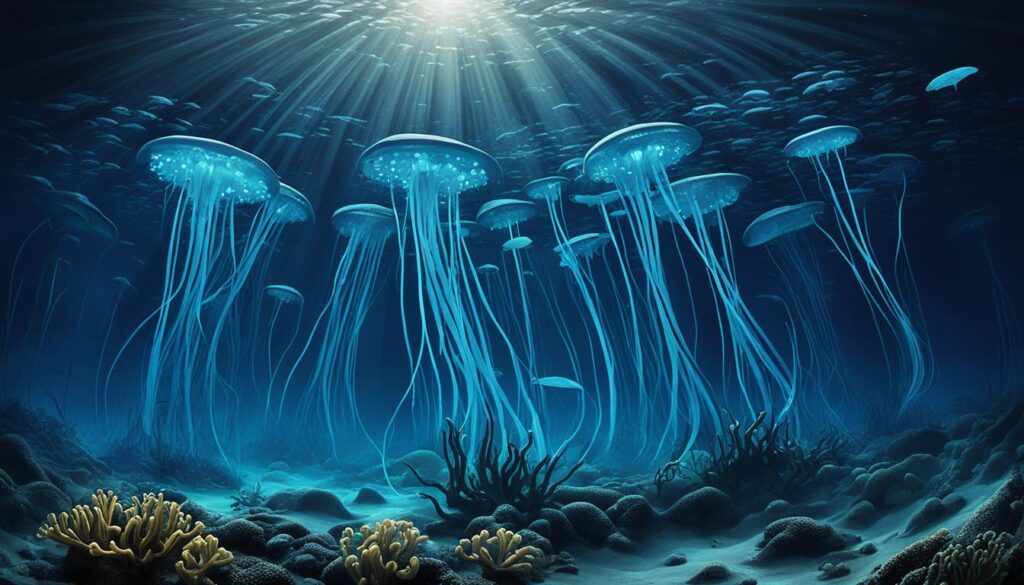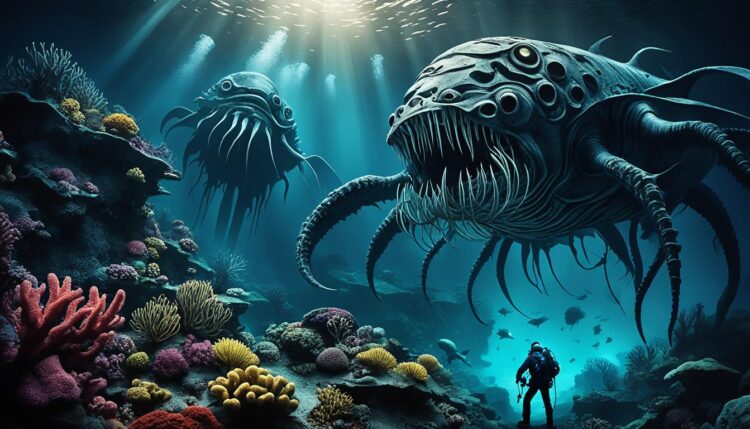Welcome to the enthralling realm of deep-ocean exploration, where the world’s greatest oceanic mysteries unfold. Beneath the ocean’s surface lies a world of awe-inspiring beauty, uncharted territories, and a myriad of enigmatic marine life. Submersible vessels pave the way for mankind to uncover these submerged secrets, revealing both the grand spectacle of bioluminescent phenomena and the resilient organisms thriving in such severe conditions.
The deep sea is not just a repository of natural wonders, it holds a key to advancing scientific understanding that spans from biomedical applications to deeper insights into Earth’s geological history. As we embark on these explorations, it is vital to consider the significance of sustainability and conservation efforts to protect these fragile ecosystems for future generations. Dive with us into the unknown, and awaken your curiosity about the mysteries of the deep sea.
Key Takeaways
- The deep sea harbors a wide range of undiscovered marine life and habitats.
- Deep-ocean exploration is crucial for advancements in science and medicine.
- Submersible vessels enable humans to explore the extreme depths of the ocean.
- Sustainability and conservation are essential in preserving deep-sea ecosystems.
- Bioluminescence adds to the captivating allure of deep-sea environments.
Introduction to Deep-sea Trenches
The captivating realm beneath the ocean’s surface is filled with hidden wonders that await in the darkness. Among these are the deep-sea trenches, which present one of the most intriguing ocean floor mysteries. These natural phenomena come to life through a combination of marine geology and the dynamic processes that shape the ocean floor. The exploration of these regions reveals a world where beauty intersects with science, inspiring awe in both explorers and researchers.
Understanding the Deep Ocean
To appreciate the marvels of deep-sea trenches, one must first understand the vast and enigmatic realm of the deep ocean. This part of the ocean consists of intricate deep sea ecosystems teeming with unique species, adapted to survive in extreme conditions. The immense pressures and lack of light create an environment distinct from any other on Earth. The study of these ecosystems lends valuable insights into marine geology and the complex mechanisms that sustain life under such harsh circumstances.
The Formation of Trenches
Deep-sea trenches are formed through the process of tectonic plate collisions. When an oceanic plate subducts beneath a continental plate, it creates a trench characterized by bone-crushing pressure and freezing temperatures. Despite these harsh conditions, these trenches support life forms that have adapted to the extreme environment. This interaction of geological processes contributes significantly to our understanding of marine geology and adds layers to the ocean floor mysteries scientists strive to unravel.
Exploring these trench formations not only provides glimpses into Earth’s geological past but also helps researchers understand the diverse deep sea ecosystems that thrive miles beneath the surface. The complex and often treacherous conditions of the deep ocean have sparked curiosity and continue to inspire scientific innovations aimed at uncovering the secrets hidden in the ocean’s depths.
Descending into the Abyss: The Challenges and Preparations
Venturing into the deep-sea trenches requires a harmonious blend of advanced technology, meticulous planning, and strict training. This endeavor is not for the faint-hearted; it demands state-of-the-art deep-sea submersibles and remotely operated vehicles (ROVs) to withstand the extreme pressures of the ocean’s abyss.
The science that drives deep-sea exploration encompasses numerous disciplines, each contributing to the intricate puzzle of reaching unparalleled depths. The development and deployment of deep-sea submersibles have revolutionized our approach, allowing researchers to explore the ocean’s depths with unprecedented precision.
The Science Behind Deep-sea Exploration
Among the significant exploration challenges are the ocean’s crushing pressures and frigid temperatures. Deep-sea submersibles, designed with robust materials and advanced technology, are crucial in overcoming these barriers, enabling scientists to delve deeper into the ocean than ever before.
ROVs, meanwhile, offer a versatile solution for probing the seabed remotely. These unmanned devices are equipped with high-definition cameras, mechanical arms, and sensors to collect samples and data from otherwise inaccessible regions. These vehicles have expanded our understanding of marine life and geological formations in the ocean’s most hostile environments.
| Deep-sea Exploration Technology | Capabilities | Main Users |
|---|---|---|
| Deep-sea Submersibles | Withstand extreme pressures, collect samples, map ocean floor | Marine biologists, oceanographers, geologists |
| ROVs | Remotely examine and sample deep-sea environments | Researchers, underwater archaeologists, environmental scientists |
Preparing for deep-sea missions involves rigorous training, ensuring personnel can handle the technical and physical demands of such expeditions. This preparation is essential not only for the safety of the crew but also for the success of the mission, pushing the boundaries of our knowledge about the ocean’s deepest mysteries.
Illuminating the Dark: Bioluminescence in the Deep Sea
In the profound depths of the ocean, where sunlight cannot penetrate, a stunning array of bioluminescent marine life thrives in the darkness. These remarkable creatures have evolved to produce their own light, creating captivating deep sea light phenomena that serve various purposes.
Bioluminescence is a natural wonder that leaves scientists and explorers in awe. Marine organisms like jellyfish, plankton, and certain species of fish emit light through a chemical reaction in their bodies. This bioluminescent ability is not just for show—it’s a vital adaptation for survival. Some creatures use it to attract mates, others to disorient predators, and some to lure prey into their grasp.
This phenomenon is not only beautiful but also integral to the deep sea ecosystem. The light displays performed by bioluminescent marine life can transform the inky darkness into a glowing spectacle, creating a surreal underwater world. Studying these light shows provides scientists with valuable insights into the behavior and interactions of deep sea organisms.
The science behind bioluminescence is both intriguing and enlightening. Researchers have discovered that the process involves luciferin, a light-emitting molecule, and luciferase, an enzyme that catalyzes the light-producing reaction. The specific light patterns and colors vary among species, contributing to the diverse deep sea light phenomena observed in the ocean’s depths.
For those fortunate enough to witness it, the sight of bioluminescent marine life is nothing short of magical. Whether observed through submersibles or captured on high-definition cameras, these underwater light shows offer a glimpse into a hidden part of our planet. As science progresses, there is hope that we will unearth even more secrets about these luminous marvels and their role in marine ecosystems.
- Attraction of Mates
- Prey Luring
- Predator Evasion
- Communication
Bizarre Beings: Unveiling Deep-Sea Creatures
The deep-sea environment presents extreme conditions that necessitate incredible adaptations for survival. Within the mysterious depths of the Mariana Trench, creatures have developed unique survival strategies to thrive in total darkness, immense pressure, and limited resources. These deep sea adaptations are nothing short of extraordinary.
Adaptations to Extreme Conditions
Many deep-sea creatures exhibit fascinating adaptations that enable them to endure their harsh surroundings. Some possess cartilaginous bodies that are more flexible than bony structures, which helps them survive the crushing pressures of the deep. Others, like the notorious anglerfish, use bioluminescence to attract prey in the pitch-black waters. This natural light source stems from symbiotic bacteria residing in specialized organs known as photophores.
Notable Species: Giant Squids and Anglerfish
The deep sea is home to some of the most elusive and intriguing species known to science. Among them, the giant squids have captured the human imagination for centuries. These colossal cephalopods can reach lengths of up to 43 feet and possess the largest eyes in the animal kingdom, aiding them in detecting faint light and shadows in the abyss.
The anglerfish, with its peculiar method of predation, stands out as another fascinating inhabitant of the deep. The female anglerfish exhibits extreme sexual dimorphism, with the male often being significantly smaller and fusing to the female’s body for survival.
| Species | Notable Adaptations |
|---|---|
| Giant Squids | Large eyes for low light detection, cartilaginous body structure |
| Anglerfish | Bioluminescent lure, extreme sexual dimorphism |
Exploring Hidden Wonders: Submarine Volcanoes and Hydrothermal Vents
The ocean floor is home to extraordinary geological features that captivate scientists and adventurers alike. Among these are submarine volcanoes and hydrothermal vents, both of which play a critical role in underwater geology and the evolution of marine ecosystems.
Geological Marvels of the Ocean Floor
Submarine volcanoes are fascinating geological structures that form beneath the ocean’s surface. They emerge in tectonically active areas and create an underwater landscape marked by towering peaks and expansive lava flows. These volcanoes contribute significantly to the underwater geology by shaping the seafloor and influencing oceanic circulation patterns.
Hydrothermal vents, often located near these submarine volcanoes, are another remarkable feature. They release mineral-rich water heated by the Earth’s magma, creating an environment that supports unique ecosystems. The interaction of seawater with magma and volcanic rock gives rise to hydrothermal plumes rich in metals and other elements, promoting a biodiverse habitat for specialized marine life.
Significance of Hydrothermal Vents
Hydrothermal vents are not only crucial for their unique ecosystems but also for their role in our understanding of life’s origins. The extreme conditions near these vents, characterized by high temperatures and pressures, mimic those that may have existed on early Earth, providing clues about how life could begin. Additionally, the study of these vents has implications for the search for extraterrestrial life, as similar conditions could exist on other celestial bodies.
| Feature | Description | Significance |
|---|---|---|
| Submarine Volcanoes | Underwater mountains formed by volcanic activity. | Influence seafloor morphology and ocean circulation. |
| Hydrothermal Vents | Hot springs on the seafloor releasing mineral-rich water. | Support unique ecosystems and provide insights into life’s origins. |
In conclusion, the study of submarine volcanoes and hydrothermal vents is pivotal for advancing our understanding of underwater geology. These geological marvels underscore the interconnectedness of oceanic processes and the global ecosystem’s complexity.
Deep-sea Trenches: The Mariana Trench and Beyond
The Mariana Trench, known as the deepest point on Earth, presents a unique ecosystem shaped by extreme pressure, cold temperatures, and perpetual darkness. This remarkable environment is a hotbed of scientific interest, revealing fascinating insights into deep-sea biodiversity and tectonic activity.

The trench’s depth exceeds 36,000 feet, making it an inhospitable domain for most life forms. However, despite these severe conditions, a myriad of organisms thrive here, adapting in extraordinary ways. Species like the snailfish have evolved to withstand the immense pressure, showcasing the resilience of nature.
Deep-sea biodiversity within the Mariana Trench includes numerous undiscovered species, many of which exhibit unique adaptations like bioluminescence and specialized diets. These adaptations are crucial for survival, enabling organisms to find food and mates in the pitch-black environment.
Moreover, tectonic activity continuously shapes the Mariana Trench. The subduction zones, where one tectonic plate dives beneath another, generate some of the Earth’s most powerful seismic events. These dynamic geological processes contribute to the trench’s constantly evolving landscape.
Despite its remote location, the Mariana Trench is not immune to human impact. Pollutants like microplastics and chemicals have been found even in the deepest waters, demonstrating the far-reaching effects of human activity on deep-sea ecosystems. Efforts to understand and mitigate these impacts are essential for preserving the fragile balance of these underwater worlds.
| Mariana Trench | Characteristics |
|---|---|
| Depth | 36,000+ feet |
| Temperature | Near freezing |
| Main Features | Biodiversity, tectonic activity |
| Human Impact | Pollution |
Unearthing Mysteries: Recent Scientific Discoveries
The depths of the ocean continue to surprise scientists with their abundance of new species and unique ecosystems. Recent marine scientific breakthroughs have unveiled a myriad of discoveries, shedding light on the remarkable adaptations found in deep-sea genetics. These pioneering studies not only broaden our understanding of aquatic life but also hold significant potential for biotechnology and medical research.
New Species and Unique Ecosystems
Exploration missions have revealed numerous new species thriving in the astounding environments of deep-sea trenches. Among these marine scientific breakthroughs is the discovery of bioluminescent organisms that use glow-in-the-dark mechanisms for communication and predation. Moreover, hydrothermal vent ecosystems harbor bacteria capable of chemosynthesis, an incredible adaptation to extreme conditions. These findings highlight the rich biodiversity awaiting further examination.
Deep-sea Biotechnology and Medical Research
The untapped potential of deep-sea genetics offers promising avenues for biotechnology and medical advancements. Through the study of unique enzymes and biochemical compounds produced by deep-sea organisms, researchers aim to develop novel pharmaceuticals and treatments for various diseases. For example, marine sponges have yielded compounds with potent anti-cancer properties, demonstrating the far-reaching implications of deep-sea exploration.
Below is a table summarizing recent discoveries and their scientific significance:
| Discovery | Scientific Significance |
|---|---|
| Bioluminescent Organisms | Understanding communication and predation in extreme environments |
| Hydrothermal Vent Bacteria | Insights into chemosynthesis and adaptable life forms |
| Deep-sea Sponges | Potential development of anti-cancer compounds |
The continuous exploration and study of these deep-sea entities promise a wealth of knowledge, showcasing the profound impact of marine scientific breakthroughs on multiple scientific fields.
The Impact of Human Activity on Deep-sea Ecosystems
The uncharted depths of our oceans are increasingly becoming a battleground against the adverse effects of human activities. One of the most pressing concerns facing our planet today is the environmental impact of deep-sea pollution, which threatens the delicate ecosystems of our ocean floors. Conservationists and scientists are scrambling to find solutions while understanding the long-term implications of these activities.
Pollution and Microplastics
Deep-sea pollution has manifested in various forms, with microplastics being among the most insidious. These tiny plastic fragments have been found in some of the most remote ocean trenches, such as the Mariana Trench. The presence of these pollutants in such isolated environments highlights the far-reaching impact of human activities. Microplastics not only contaminate the water but also affect the health and survival of marine organisms, disrupting the entire deep-sea ecosystem.
Conservation Efforts and Initiatives
Recognizing the urgent need for ocean conservation, various international organizations and marine biologists have launched significant initiatives aimed at mitigating environmental impact. These efforts include stricter regulations on plastic production and disposal, as well as the promotion of sustainable practices. For global ocean conservation to succeed, international cooperation is essential. Governments, environmental organizations, and local communities must work together to protect and preserve the biodiversity of our deep-sea environments.
A detailed look at the ongoing efforts includes:
| Initiative | Description | Impact |
|---|---|---|
| Plastic Ban Policies | Legislation banning single-use plastics | Reduction in plastic waste entering oceans |
| Marine Protected Areas | Designation of regions where marine life is protected from human activities | Preservation of biodiversity and ecosystems |
| Clean-up Operations | Initiatives to remove existing marine debris | Immediate reduction in deep-sea pollution levels |
The combined effect of these initiatives represents a major step forward in addressing the environmental impact of human activities on deep-sea ecosystems. However, the journey towards fully sustainable oceans is ongoing, demanding continuous vigilance and innovation.
Innovations in Deep-Sea Exploration Technology
The quest to understand the mysteries of the deep-sea trenches has driven technological advancements that are revolutionizing deep-sea research. Innovations in exploration technology, such as manned submersibles and remotely operated vehicles (ROVs), have dramatically expanded our ability to explore the ocean’s depths safely and efficiently.
Manned Submersibles and ROVs
Manned submersibles have enabled scientists to descend into the heart of the ocean, offering firsthand experiences and direct observations of deep-sea environments. These submersibles, like the famous DSV Alvin operated by Woods Hole Oceanographic Institution, are equipped with high-definition cameras and robotic arms, allowing for precise sampling and detailed study of underwater ecosystems. Complementing these are ROVs, which provide a more flexible and extended exploratory capability. ROVs are particularly valuable for their ability to reach extreme depths and conduct prolonged missions without the risks associated with human presence.
Future Perspectives on Deep-sea Research
The future of deep-sea research is promising, thanks to ongoing technological advancements. Innovations on the horizon include next-generation autonomous underwater vehicles (AUVs) that can map the ocean floor with unprecedented accuracy and new sensors for real-time monitoring of deep-sea conditions. Moreover, international collaborations are critical in pushing the boundaries of what we can achieve, as seen in initiatives like the UN Decade of Ocean Science. These endeavors aim to harness technology not only to unveil the secrets of the deep sea but also to understand its role in broader ecological systems and address pressing environmental concerns such as climate change.











